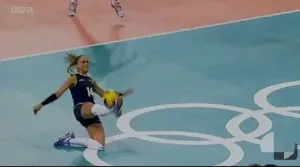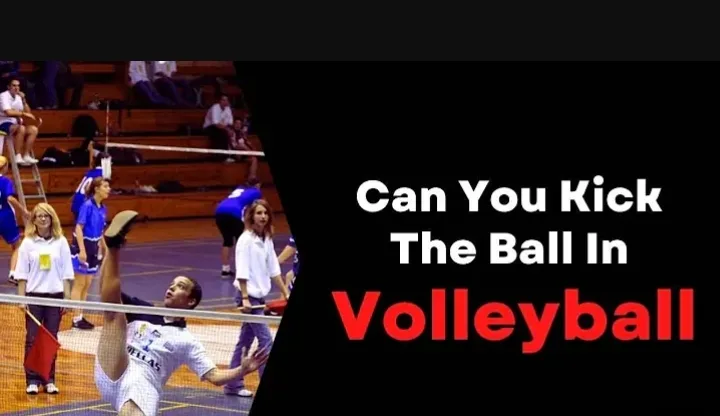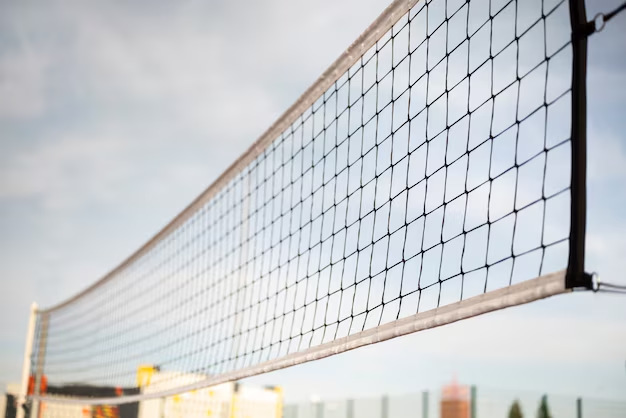When most people think of volleyball, they imagine players skillfully using their hands to hit, set, or block the ball. But did you know there’s a specific rule about using your feet too? That’s right! The kicking ball volleyball rule is one of the lesser-known yet important aspects of the game that can come in handy during fast-paced, intense moments. Let’s dive into what the rule actually says and how it plays out in real matches.
Kicking ball volleyball rule: Can You Kick the Ball in Volleyball?

Yes, according to the kicking ball volleyball rule, you are allowed to kick the ball in volleyball. This might come as a surprise to many casual players who believe that only hands and arms are used in the sport.
The rule was introduced by the FIVB (International Volleyball Federation), allowing players to use any part of their body, including their feet, to keep the ball in play.
Previously, volleyball was strict about using only the upper body, but the modern game has evolved, opening up more opportunities for dynamic, creative plays. So, the next time you’re in a tight situation, remember—you can kick the ball!
When and How Kicking is Allowed in Volleyball

The kicking ball volleyball rule allows you to kick the ball as long as it’s a legal contact. This means:
- The ball must be kicked without committing any faults, such as touching the net or going out of bounds.
- You can kick the ball intentionally, though this is usually done as a last-ditch effort to keep the play alive.
- Both indoor and beach volleyball allow kicks, making this rule universally applicable.
For example, if the ball is too low for you to reach with your hands, a quick reaction with your foot could save the point. However, be careful—since volleyball is a game of precision, controlling a kick can be much harder than using your hands or arms.
See Also: New volleyball rules 2024 – 2025 Season
Advantages and disadvantages of Kicking the Ball
Using your foot to hit the ball can sometimes be a game saver. There are clear advantages to being able to kick the ball in volleyball, such as:
- Quick Reflexes: When the ball comes in low or fast, using your foot can be the quickest way to react.
- Last-Resort Saves: If you’re diving for a ball or it’s out of your normal reach, a well-timed kick might keep the play alive.
However, there are also some downsides to kicking the ball:
- Lack of Control: Feet are less precise than hands, and you may lose accuracy, making it harder to direct the ball to your intended target.
- Injury Risk: Kicking the ball can put extra strain on your leg muscles, increasing the risk of injury if not done properly.
Famous Instances of Kicking in Volleyball
In professional volleyball, there have been some notable moments where players have successfully kicked the ball during critical points. For instance, during a World League match, a Brazilian player made a brilliant save by kicking the ball when it seemed impossible to reach it with his hands. The play went viral, demonstrating just how effective the kicking ball volleyball rule can be.
While these moments are rare, they show that kicking can sometimes turn the tide of the game, especially when every second and movement counts.
Kicking Ball Volleyball Rule in Different Leagues
Different volleyball leagues, from FIVB to NCAA, allow kicks under the same rules. Whether it’s indoor volleyball, beach volleyball, or even recreational games, the kicking ball volleyball rule applies.
In recreational or local leagues, however, some variations in rules might exist. It’s always a good idea to check the specific rules of the league you’re playing in, as some may have different interpretations or restrictions on foot contact.
Impact of Kicking on Gameplay and Strategy
While kicking is not a primary strategy in volleyball, knowing you have the option can be a huge relief in those high-pressure moments. Teams rarely train for it, but incorporating it into emergency situations could add a new layer of unpredictability to your game.
For example, if you’re a libero or defensive specialist, a well-timed kick could save a ball that would otherwise be impossible to reach. This can turn a defensive play into an opportunity to counterattack.
Penalties for Illegal Kicks in Volleyball
While the kicking ball volleyball rule allows foot contact, there are situations where a kick may result in a penalty. An illegal kick can occur if:
- The ball is kicked out of bounds or into the net.
- The kick leads to a violation, like a double touch or held ball.
- A kick is used in an unsportsmanlike manner.
If these occur, the opposing team will be awarded the point.
Should You Train to Kick the Ball in Volleyball?
It’s debatable whether players should actively train to kick the ball. While it’s good to be aware of the rule and be ready to use it, volleyball is a sport built on hand-eye coordination, and most drills focus on that.
However, practicing quick reflexes and foot-eye coordination can make you better prepared for emergencies.
If you play frequently, especially at a competitive level, it doesn’t hurt to practice a kick every now and then—just don’t rely on it too much!
Conclusion
The kicking ball volleyball rule opens up new possibilities in volleyball, especially in tight, high-pressure moments. While it’s not something you’ll use often, it’s a valuable tool when you need to make a last-minute save. Understanding the rule and knowing when and how to use it could make all the difference during a match.
See Also: 18 Cute Volleyball Hairstyles for Girls and Men Volleyball Players
FAQs
1. Can you legally kick the ball in volleyball?
Yes, you can kick the ball in volleyball. The FIVB rules allow players to make contact with the ball using any part of their body, including their feet. This rule applies to both indoor and beach volleyball.
2. Are there any penalties for kicking the ball in volleyball?
Kicking the ball is legal, but if the kick results in a violation, such as sending the ball out of bounds or into the net, the opposing team will be awarded the point. Intentional kicks that are unsportsmanlike may also result in penalties.
3. Should I practice kicking the ball in volleyball?
While it’s not a primary skill, practicing kicks can help you be prepared for emergency situations. Kicking is most useful as a last resort move when you can’t reach the ball with your hands or arms.
4. Do different leagues allow kicking the ball in volleyball?
Yes, most major leagues, including FIVB, NCAA, and beach volleyball, allow kicking the ball. However, some recreational or local leagues may have specific rules, so it’s best to check with your league organizers.
5. What are the risks of kicking the ball in volleyball?
The main risks of kicking the ball include lack of control, which can make it hard to direct the ball accurately. Additionally, there’s a higher chance of injury if the kick is not executed properly, particularly to the leg muscles.
By understanding the kicking ball volleyball rule, you can elevate your gameplay and handle those tricky, fast-paced moments with more confidence.




